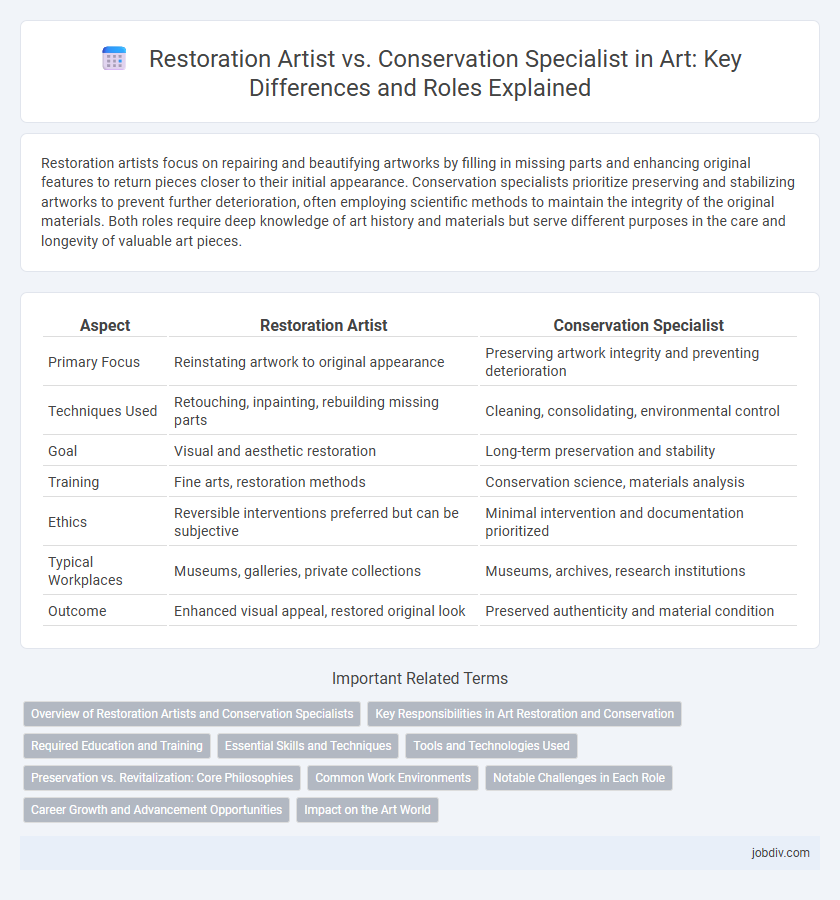Restoration artists focus on repairing and beautifying artworks by filling in missing parts and enhancing original features to return pieces closer to their initial appearance. Conservation specialists prioritize preserving and stabilizing artworks to prevent further deterioration, often employing scientific methods to maintain the integrity of the original materials. Both roles require deep knowledge of art history and materials but serve different purposes in the care and longevity of valuable art pieces.
Table of Comparison
| Aspect | Restoration Artist | Conservation Specialist |
|---|---|---|
| Primary Focus | Reinstating artwork to original appearance | Preserving artwork integrity and preventing deterioration |
| Techniques Used | Retouching, inpainting, rebuilding missing parts | Cleaning, consolidating, environmental control |
| Goal | Visual and aesthetic restoration | Long-term preservation and stability |
| Training | Fine arts, restoration methods | Conservation science, materials analysis |
| Ethics | Reversible interventions preferred but can be subjective | Minimal intervention and documentation prioritized |
| Typical Workplaces | Museums, galleries, private collections | Museums, archives, research institutions |
| Outcome | Enhanced visual appeal, restored original look | Preserved authenticity and material condition |
Overview of Restoration Artists and Conservation Specialists
Restoration artists focus on repairing and reconstructing damaged artworks to restore their original appearance, employing techniques such as inpainting and structural stabilization. Conservation specialists emphasize preserving the integrity and longevity of cultural objects through preventive measures, scientific analysis, and minimal intervention. Both roles require expertise in art history, chemistry, and material science to ensure ethical and effective treatment of artworks.
Key Responsibilities in Art Restoration and Conservation
Restoration artists focus on repairing and retouching artworks to restore their original appearance while maintaining artistic integrity. Conservation specialists prioritize preventive care, analyzing materials and environmental factors to halt deterioration and preserve artworks over time. Both roles require deep knowledge of art history, chemistry, and materials science to ensure the longevity and authenticity of cultural heritage.
Required Education and Training
Restoration artists typically require a degree in fine arts or art history, often supplemented by specialized courses in restoration techniques and materials. Conservation specialists usually hold advanced degrees in conservation science, chemistry, or cultural heritage, alongside practical training in diagnostic methods and preventive care. Both professions emphasize hands-on apprenticeships and continuous education to stay updated with evolving preservation technologies.
Essential Skills and Techniques
Restoration artists excel in skills such as color matching, paint application, and surface finishing to accurately reconstruct damaged artworks while maintaining their original aesthetic. Conservation specialists focus on scientific techniques, including material analysis, stabilization processes, and environmental control, to prevent further deterioration and ensure long-term preservation. Both require expertise in art history, chemistry, and meticulous attention to detail to maintain the integrity and authenticity of cultural heritage artifacts.
Tools and Technologies Used
Restoration artists primarily utilize fine brushes, pigments, and solvents tailored for retouching and reintegrating original artworks, often employing magnification tools and color matching technologies to ensure seamless repairs. Conservation specialists rely on advanced diagnostic equipment such as X-ray fluorescence (XRF), infrared reflectography, and digital microscopy to analyze the artwork's composition and condition before intervention. Both professionals integrate digital imaging software and climate-controlled tools to monitor and preserve artworks, though conservation focuses more on preventive methods while restoration emphasizes aesthetic renewal.
Preservation vs. Revitalization: Core Philosophies
Restoration artists focus on revitalization by carefully reconstructing damaged or aged artworks to restore them to their original or intended appearance, emphasizing aesthetic renewal and historical authenticity. Conservation specialists prioritize preservation through preventive measures and minimal intervention, aiming to stabilize and protect the artwork's current condition to ensure long-term durability and prevent further deterioration. These contrasting core philosophies reflect the fundamental balance between safeguarding original materials and enhancing visual integrity within the art preservation field.
Common Work Environments
Restoration artists and conservation specialists typically work in museums, galleries, and cultural heritage institutions where they handle valuable artworks and historical objects. Both professionals often collaborate in climate-controlled studios designed to prevent deterioration while allowing meticulous treatment and preservation processes. Their environments are equipped with advanced tools and materials to ensure the integrity and longevity of paintings, sculptures, textiles, and other cultural artifacts.
Notable Challenges in Each Role
Restoration artists face the challenge of accurately recreating missing or damaged elements while maintaining the artwork's original aesthetic and historical integrity. Conservation specialists encounter difficulties in stabilizing fragile materials and preventing further deterioration without altering the artwork's authenticity. Both roles require in-depth knowledge of materials, techniques, and art history to balance preservation with intervention.
Career Growth and Advancement Opportunities
Restoration artists specialize in repairing and revitalizing artworks, often gaining career growth through mastering traditional techniques and expanding their portfolio across various media, while conservation specialists focus on preserving art using scientific methods, advancing by acquiring expertise in chemistry, materials science, and preventive care. Restoration artists tend to progress by collaborating with galleries and private collectors, whereas conservation specialists often find advancement within museums, research institutions, and cultural heritage organizations. Both careers demand continuous education but diverge in skill sets, with restoration artists emphasizing aesthetic renewal and conservation specialists prioritizing long-term preservation.
Impact on the Art World
Restoration artists play a crucial role in reviving the original aesthetic and structural integrity of artworks, ensuring their visual appeal and historical authenticity remain intact for future generations. Conservation specialists focus on preventive care and scientific analysis to safeguard art from deterioration, employing advanced techniques to extend the lifespan of cultural heritage. Both professions significantly impact the art world by balancing preservation with restoration, thereby maintaining the cultural and historical value of priceless artworks.
Restoration Artist vs Conservation Specialist Infographic

 jobdiv.com
jobdiv.com